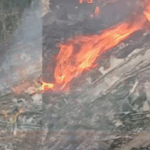
Following the devastating military helicopter crash that claimed the lives of eight individuals, including two government ministers, questions are mounting over what went wrong aboard the Ghana Armed Forces (GAF) aircraft, reportedly procured from China.

As the nation mourns, attention now turns to a small but vital device that may hold the answers: the black box.
What is a Black Box?
The black box is neither black nor mysterious. It is, in fact, a bright orange-coloured, crash-hardened device that records essential information during a flight. Those who are familiar with National Geographic’s Air Crash Investigation documentary would realise that the black box is very critical.
In aviation, it plays a central role in post-crash investigations, helping aviation experts understand the events that led to an accident.
Each black box comprises two key components:
- Flight Data Recorder (FDR): This logs critical technical data such as altitude, airspeed, engine performance, and the flight path.
- Cockpit Voice Recorder (CVR): This captures all sounds from within the cockpit, including conversations between the pilots and other audio cues from the flight deck.
Together, these two recorders can store over 25 hours of flight metrics and two hours of audio recordings—an invaluable archive for investigators.
Why is it crucial for Ghana’s investigation?
In the wake of such a high-level and tragic incident, the black box becomes the most sought-after tool in determining the cause of the crash.
Whether the tragedy stemmed from mechanical failure, environmental conditions, or human error, the data recovered will provide investigators with an unfiltered account of the final moments of the flight.
This insight is not only essential for bringing closure to the grieving families and the nation but also for enhancing operational safety within Ghana’s military and aviation sectors.
Can it survive the crash?
Looking at the state of the burnt aircraft, are you wondering if the black box can be recovered? Yes, it can be recovered because black boxes are engineered to endure the most extreme conditions.
Typically located in the aircraft’s tail, the part is most likely to survive a crash. The device is designed to:
- Withstand temperatures of up to 1,100°C for at least one hour
- Survive pressures found at depths of up to 6,000 metres underwater
- Endure impacts up to 3,400 times the force of gravity
Moreover, it emits an underwater locator signal for 30 days to aid recovery teams in locating the device.
Is it easy to decode?
According to Air Crash Investigations, not immediately.
While recovering the black box is a critical milestone, extracting and interpreting its data is complex and time-intensive. Specialists require advanced forensic tools, and depending on the damage sustained, a full analysis may take several weeks or even months.
Nonetheless, once decoded, the findings will be instrumental in guiding Ghana’s aviation safety protocols, refining military procedures, and, most importantly, preventing future tragedies.
As Ghana reflects on this painful moment, the black box remains a symbol of both hope and accountability, a silent witness to a tragedy that demands answers and action.
In my opinion, the government should prioritise engaging competent air crash investigators to unlock what occurred and offer the needed recommendations that will make an impact in the country.
The writer of this explainer, Albert Kuzor, is a JoyNews Journalist.
- President Commissions 36.5 Million Dollars Hospital In The Tain District
- You Will Not Go Free For Killing An Hard Working MP – Akufo-Addo To MP’s Killer
- I Will Lead You To Victory – Ato Forson Assures NDC Supporters
Visit Our Social Media for More




